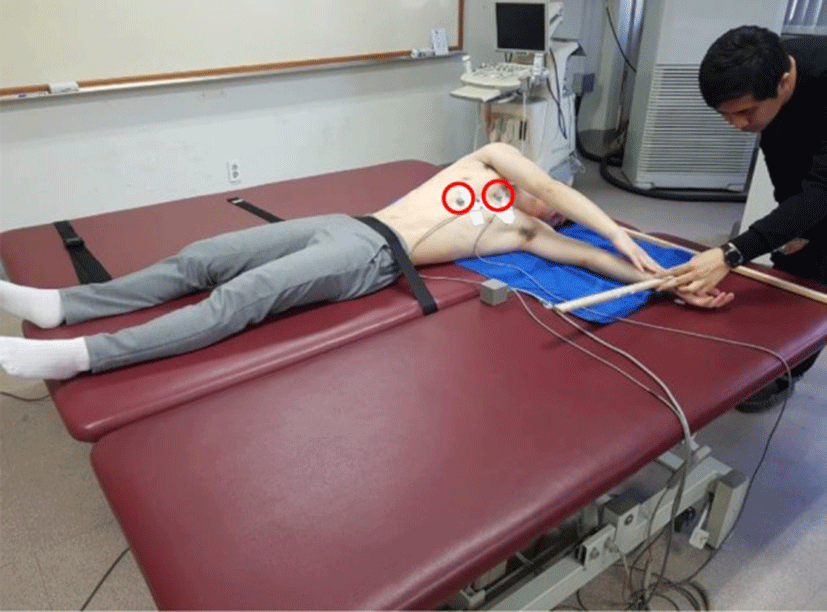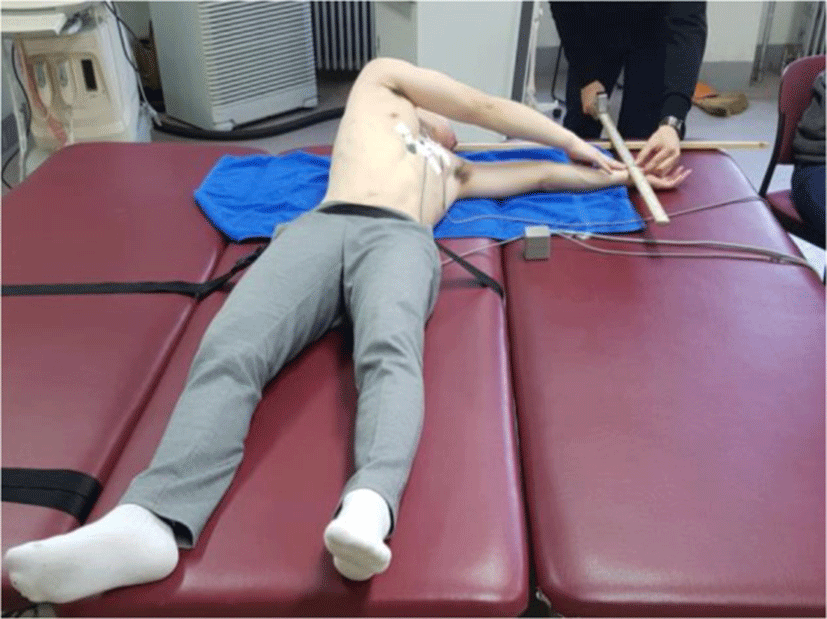INTRODUCTION
Trunk rotation movement includes the coordinated upper and lower segment motion of the thoracolumbar spine.1 Rocket sports activities, such as tennis and golf, and daily activities require whole-thoracolumbar rotation.2,3 The thoracolumbar spine has a rotational motion approximately 40-74 degrees in the horizontal plane.4-6
To measure the thoracolumbar rotation, previous studies have used a three-dimensional motion analysis system, goniometry, and inclinometer.5,7-9 Except for the goniometry measurement, the other measurements showed excellent-good reliability and a low level of measurement error.9,10 However, a three-dimensional motion analysis system is expensive and requires considerable space.7 Therefore, clinicians need an easy and accurate measurement tool to measure thoracolumbar rotation.
Previous studies of measuring axial-thoracolumbar rotation have been performed in the open kinetic chain, such as the sitting or standing posture of the thoracolumbar spine without pelvis fixation.6,11,12 These methods may be difficult to measure the exact axial-thoracolumbar rotation without compensatory movement of the pelvis. To measure axial-thoracolumbar rotation in the closed kinetic chain, Kim et al. (2017) measured thoraco-lumbar-pelvic rotation in the supine position with upper thorax fixation. However, there have been no studies to measure axial-thoracolumbar rotation in the closed kinetic chain. Therefore, the purpose of our study was to investigate the reliability of a new method for measuring axial-thoracolumbar rotation in the closed kinetic chain. We hypothesized that the reliability of the measurement method in the closed kinetic chain is high, and that there is no significant difference between testers and the measurement sections (jugular notch and xiphoid process).
METHODS
Fourteen healthy males (age = 24.43±1.95 years; height = 172.86±7.40 cm; mass = 71.50±10.80 kg) participated in this study. All study participants had measurements taken for both side (right and left) axial-thoracolumbar rotation. The participants completed a self-report to determine if there were any orthopedic or neurological problems in the upper extremities. Subjects were excluded from this study if they had (1) a history of fracture or traumatic injuries of the thoracic and lumbar spine or (2) a history of orthopedic surgery within the previous six months. All subjects received an explanation of this study and agreed to participate.
A Polhemus Liberty electromagnetic tracking system (Polhe-mus, Inc., Colchester, VT, USA) was used to measure the angle of axial-thoracolumbar rotation in the horizontal plane. Two sensors were attached, one at the sternum’s jugular notch and the other at the sternum’s xyphoid process (Figure 1). Upper and lower trunk kinematics was obtained from a global coordinate system in the horizontal plane, with zero displacement being the start position. The angles of axial-thoracolumbar rotation were defined as the absolute angle of the thoracolumbar rotation against a fixed pelvis. Kinematic data were collected at 120 Hz, and the mean value of the three trials was used for statistical analysis.
The examiner held practice training sessions to reduce measurement error. The participant’s initial position and the landmark point where a sensor was attached were the same for each session. In addition, all participants were given practice trials to familiarize them with the experimental procedures. For the axial-thoracolumbar rotation, the subjects performed an arm lateral reaching posture that abducted their arms 90 degrees in a supine position. The participant’s pelvis was fixed to the table with a strap to prevent rotation. For prevent side-bending movement, the shoulder and trunk of the subject were made vertical and the subjects were instructed not to bending the trunk during arm lateral reaching. Participants were asked to rotate their thorax to reach the opposite arm against the arm in the direction of rotation (Figure 2). At this time, the arm in the direction of rotation was kept in a position where it did not fall off the floor. The point where the posture can be maintained for five seconds was measured as the axial-thoracolumbar rotation (Figure 2). The participant’s performed the task twice, with a 30-second rest period for each measurement.
A two-way analysis of variance (ANOVA) was used to test for systematic differences between the first and second tests and between the two sensors. The significance level was set at α = 0.05. The intra-test and retest reliability of the axial-thoracolumbar rotation angle were calculated using the intraclass correlation coefficient (ICC). Data were analyzed using ICC (3, 1) with a 95% confidence interval (CI) to determine the relative reliability of the two test sessions for axial-thoracolumbar rotation.
RESULTS
A two-way ANOVA showed no significant difference between tester and sensor location. There was no interaction between the factors. Analysis of the ICC showed the test-retest reliability of the axial-thoracolumbar rotation. The test-retest ICC of axial-thoracolumbar rotation angle of the sensor on the jugular notch was 0.83, and angle of the sensor on the xiphoid process was 0.84 (Table 1).
| Variable | Test 1 mean (SD) | Test 2 mean (SD) | N | ICC (3,1) (95% CI) | p |
|---|---|---|---|---|---|
| Jugular | 41.51 (13.55) | 39.57 (14.38) | 28 | 0.83 (0.67 - 0.92) | < 0.01 |
| Xiphoid | 37.13 (9.62) | 35.96 (10.44) | 28 | 0.84 (0.68 - 0.92) | < 0.01 |
DISCUSSION
The purpose of this study was to evaluate the reliability of the new method for measuring axial-thoracolumbar rotation, and we found our method had high intra-rater test-retest reliability (ICC: jugular notch = 0.83, xiphoid process = 0.84). The measurement of the kinetic chain state in this study was a more accurate method than previous methods. Viitanen (1993) measured the axial rotation of the thoracolumbar level in a sitting posture. Johnson et al. (2012) measured the axial-thoracolumbar rotation in a sitting and half-kneeling posture. However, previous studies used a verbal comment to prevent compensation of lumbo-pelvic rotation, which may be susceptible to flexion and extension during axis-thoracolumbar rotation.6,13 Posture strongly influences thoracolumbar rotation.13 According to Edmondston et al. (2007), the angle of thoracolumbar rotation was significantly decreased in flexion compared with the neutral and extended postures. In this study, the subject’s pelvis was fixed to the table with a strap to prevent compensatory movements. Furthermore, axial rotation with minimized flexion and extension could be performed compared with the open chain condition because the entire spine was a closed chain in the supine posture.
It is important to measure and improve the axial-thoracolumbar rotation angle to prevent musculoskeletal pain.4,5,14 Compensated lumbo-pelvic rotation due to limited thoracolumbar rotation may cause hip joint, pelvic, and/or low back pain.1,14,15 During thoracolumbar rotation, to move ideally, the thoracolumbar spine should move in the path of instantaneous center of rotation (PICR), which is the normal amount of accessory and physiological motion available at the thoracolumbar spine.14 The lack of thoracolumbar axial rotation beyond the PICR can result in an abnormal movement pattern for the trunk during trunk rotation.1,14 Therefore, we propose this newly designed measurement method can be used for accurate axial-thoracolumbar rotation measurement and training in clinical practice.
The present study had several limitations. First, all parti-cipants were healthy males and relatively young subjects. These findings cannot be generalized to other populations involved in sports activities or other ages; further research is required to investigate comparisons of axis-thoracolumbar rotation in individuals with thoracolumbar dysfunctions. Second, this study investigated only intra-rater reliability. However, inter-rater test-retest reliability is also important. Further studies are needed to investigate inter-rater test-retest reliability to generalize this technique. Third, in this study, we only measured the new method’s reliability in the supine position to assess the axial-thoracolumbar rotation angle. Further studies are needed to investigate the validity of other task measurements using three-dimensional motion analysis system or smart phone-based measurement tool by Jung et al (2018).









